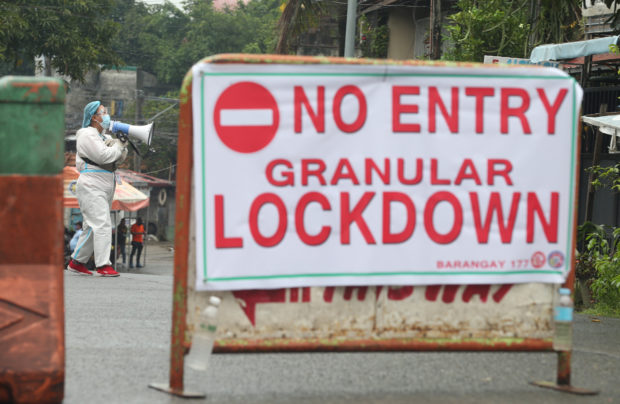Areas in granular lockdown won’t get any warning

NO ENTRY, NO EXIT Granular lockdowns will be pilot tested in Metro Manila to stop the spread of the more contagious Delta variant. —NINO JESUS ORBETA
MANILA, Philippines — Only a few houses, or maybe a street, will be covered by the newly crafted “granular” lockdown system that the government will pilot test on Sept. 16, but they will come without warning to effectively confine possible carriers.
“The smaller the granular lockdown imposed, the better for our countrymen,” said Jonathan Malaya, spokesperson for the Department of the Interior and Local Government (DILG), in a radio interview on Sunday.
“If possible, only one, two or four houses [will be] covered. If there’s community transmission, only a street,” he added, saying the new system was conceived to allow people to go to work while fighting the pandemic.
“But it will not come with a warning. You’ll find out only once imposed. The only one to know will be the city health office, which has the data,” Malaya said.
The Department of Health (DOH) will be responsible for setting the alert level in an area, he added.
“If there’s a warning, it would defeat the purpose. Affected residents would only leave that area where there’s clustering,” he explained.
Once a granular lockdown is imposed, Malaya said residents would not be allowed to leave and those who have left the area could not return until the lockdown was lifted.
The guidelines for the new system will be announced by presidential spokesperson Harry Roque on Monday or Tuesday after the Inter-Agency Task Force for the Management of Emerging Infectious Diseases finalizes them, he added.
Old idea
But the idea of localized quarantines was an old idea first proposed by presidential adviser Joey Concepcion when the country went on its first lockdown in March 2020.
But President Duterte rejected the idea in favor of a stringent quarantine system that initially proved to be effective, until the DILG allowed a number of people who were later found to be infected with the virus to return to their hometowns in Eastern Visayas.
Even after nearly two years of on-and-off lockdowns, the country’s caseload continued to increase, reaching 2,227,367 on Sunday.
There were 21,411 new infections, hiking the number of active cases to 181,951.
Deaths breach 35K
There were also 168 more deaths, bringing the official death toll to 35,145, surpassing the 34,000 deaths from the cholera pandemic that hit the country in 1881 and making the prevailing epidemic the worst in Philippine history.
Majority of the infections were mild and 25,049 more patients had recovered, bringing the total number of survivors to 2,010,271, or a recovery rate of 90.3 percent.
Of the 181,951 active cases, 86 percent were classified as mild, 9.5 percent asymptomatic while 2.59 percent are moderately ill, 1.3 percent were severe and 0.6 percent in critical condition.
Meanwhile, the positivity rate is 27 percent out of the 78,274 people tested for the virus on Sept. 10. Five laboratories did not report their test results.
Nationwide, 77 percent of ICU beds and 68 percent of isolation beds allotted for COVID-19 patients are occupied, according to the DOH.